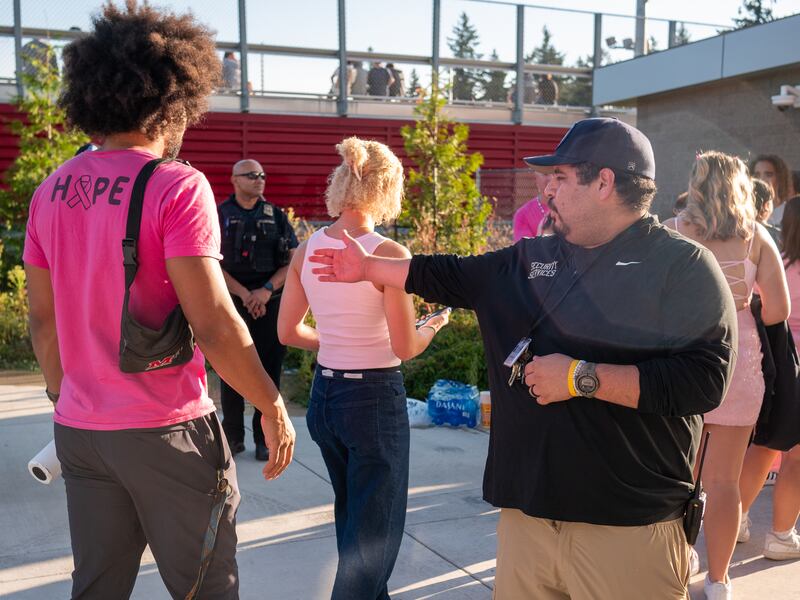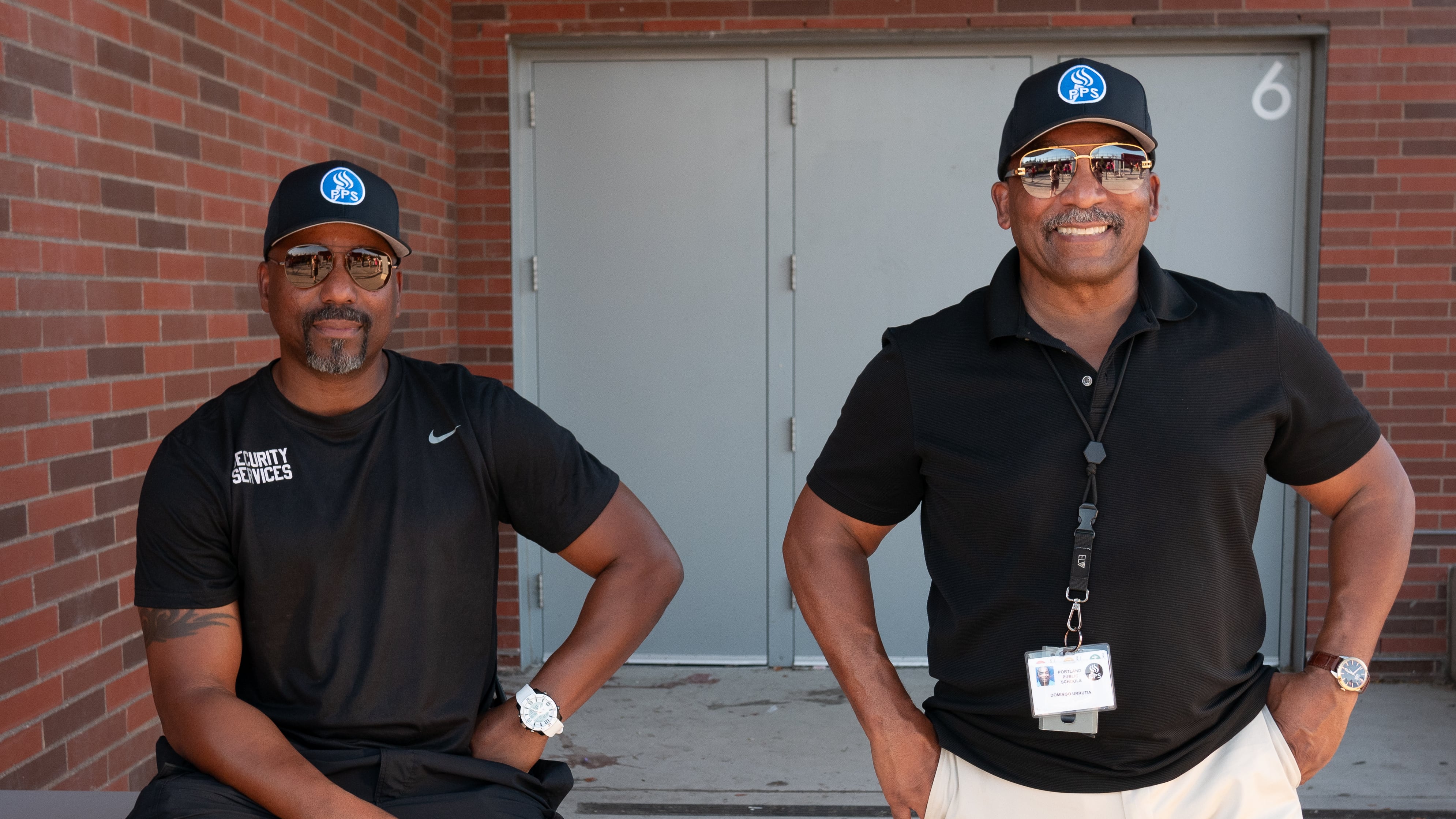The doors to Cleveland High School burst open at 3:30 pm—class dismissed—and hundreds of teenagers streamed out into the September sunshine. Greeting them on the front steps were a woman and a man, each wearing black polo shirts imprinted with “Campus Safety” on the back.
The guards carried two-way radios. They did not wear bulletproof vests or carry firearms, stun guns or pepper spray. But their job as “campus safety associates” is to maintain safe schools by patrolling campuses, building relationships with students, and intervening in and deescalating unsafe situations.
They are the replacements, painfully negotiated, for the armed, uniformed police officers who three years ago roamed school halls. They have had four hours of training.
“I always tell people they are armed with kindness,” says Molly Romay, Portland Public Schools’ director of security.
The Cleveland guardians stood about half a block from Southeast Franklin Street, where a 16-year-old student was shot and injured last December during school hours, sending the school into lockdown.
It might seem odd that the security guards defending the shampoo at Fred Meyer are packing more heat than the ones protecting students at Oregon’s largest school district. But this is the level of security that many Portlanders demanded.
In June 2020, as nightly protests spurred by the murder of George Floyd raged through downtown, PPS Superintendent Guadalupe Guerrero announced that the school district would no longer have police patrolling its hallways. Politicians such as Mayor Ted Wheeler, then-City Commissioner Jo Ann Hardesty, and two School Board members cheered the move, saying it would reduce the risk students of color experience from police.
Three years of debate and countless anguished PTA meetings have followed, as did five shootings last school year near Cleveland, Franklin and Jefferson high schools. Guerrero launched a Safety and Security Task Force to survey the community, including a dozen focus groups and seven events at schools.
The result? The district looked to campus safety associates. CSAs have been on Portland school grounds for more than 20 years, according to the district, but they used to work in tandem with a handful of school resource officers—badged, armed cops.
PPS added 17 more CSAs this school year and extended their hours, an approximately $1.3 million expense. There are four at each high school, one at each middle school, and two roving CSAs that patrol elementary schools and the K-8′s.
Board members say they are watching the results closely.
“I can say, unequivocally, it is safe for our kids in our school buildings,” School Board Chair Gary Hollands says. “Now, outside our buildings? Going to and from school? That’s different.”
Board member Julia Brim-Edwards says there never was a time when every Portland high school had its own full-time SRO. They usually covered multiple high schools, and their number could be affected by Portland Police Bureau staffing or budget issues. This is better.
“In many ways, we have a much broader safety and security team at every school, every day, than we ever had when there were SROs in the schools,” Brim-Edwards says.

The vertigo Portlanders are experiencing regarding the role of police—thousands marched to defund them in 2020, but now 19% of voters say crime is their top concern—is reflected in the public schools.
Kristen Downs, for one, wanted police officers back in her children’s school last winter. Two of her four children are recent Cleveland graduates. Many of their friends were in the stands at the Jan. 7 Cleveland basketball game at Franklin High School when shots were fired in the parking lot. A police officer was at the game and responded immediately, but attendees had to scatter to safety.
“I thought that was just appalling,” Downs says. “I said enough is enough.”
The next day, Downs started a petition to reinstate SROs. A little over 1,000 people signed it.
In May, PPS announced 13 new safety initiatives. They included community walking patrols before and after school, ID badges required for all middle and high school students, reestablishing the Police Bureau’s Youth Services Division, and a new weapons detection system. But no cops on campus.
Downs declared victory anyway and closed the petition.
“It’s not the same thing as trained SROs,” Downs says. “But baby steps are the way things are going to have to get done. It’s the first step in a long process after Portland defunded the police.” (Portland’s police budget remains at an all-time high, but it has struggled to fill vacant positions.)
Downs left Portland this summer. Her children’s new schools have SROs. “We’re in a better place,” she says.
Not surprisingly, Aaron Schmautz, president of the Portland Police Association, thinks schools would be safer with cops back in the halls. He was the sergeant in charge of the Youth Services Division in 2020 when it was disbanded.
CSAs are excellent at building relationships because they are in the hallways every day and know how to talk to the kids that struggle, Schmautz says. But he still thinks police officers belong back in schools.
“I want to be really clear that the work CSAs do was important then and it is important now,” Schmautz says. “But if you were going to build a house and you’re like, ‘I need a plumber and an electrician.’ And then someone said, ‘You can’t have a plumber.’ It’s like, ‘OK, I’ll have two electricians then.’ You need both.”
Some say school shootings are so unpredictable that police officers can’t reliably stop them anyway—cops didn’t help in Uvalde, Texas, or Parkland, Fla.
Others argue that students of color and students with disabilities have understandable reason to feel less safe with armed police roaming the halls. Plus, the U.S. Department of Education found that Black students at schools with police are 2.3 times more likely than white students to receive a referral to law enforcement or have a school-related arrest.
Angela Bonilla, president of the Portland Association of Teachers, believes the focus should be on prevention, not police.
“We can’t keep treating the symptoms, we have to treat the illness,” Bonilla says. “Where are all the investments in school psychologists and counselors and mental health needs?”
The CSA’s four-hour basic training program includes emergency preparedness and response, suicide prevention, conflict management, deescalation, and learning the Department of Homeland Security’s active threat response. Once they begin, CSAs receive at least 48 hours of professional development each school year. According to their job description, hazards include “occasional violence or threat of violent behavior” and the position requires “strength to restrain individuals from committing violence.”
When asked if CSAs can prevent and stop school shootings, PPS security director Romay says, “Absolutely.”
“The trusting relationships they build both with students and the parent community allows them to naturally be violence interrupters,” she says.
However, an unnamed CSA on Guerrero’s Safety and Security Task Force reported in a May district document: “Weapons are everywhere. We need solutions that can detect them.”
That warning was part of what inspired the district to purchase a walk-through weapons detection system for use at major events. The high-speed OpenGate pillars debuted at the Sept. 15 football game at McDaniel High School.
The school district tries to hire CSAs who are either from the community or have established relationships with the school or campus they’re staffing. Some are parents of current students.
PPS declined to make a CSA available for an interview after two weeks of requests by WW.
Three School Board members contacted by WW say they are, for the moment, satisfied with the compromise.
“Everyone we talked to agreed that when there’s a school shooting or a violent act, we need to involve the police in that,” says board member Andrew Scott. “I think the real question becomes who do we want inside of our school buildings on a daily basis? And, at least for now, the answer to that was campus safety associates.”
